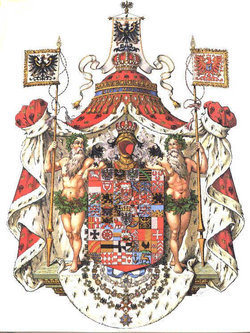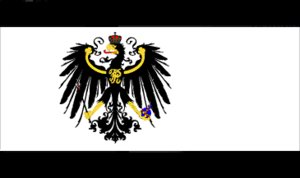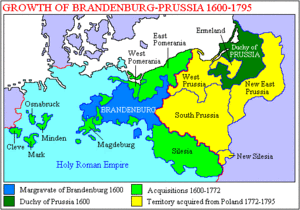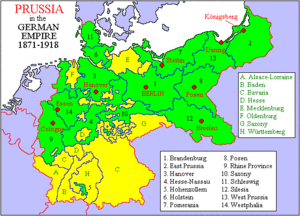Prussia
|
|
The word Prussia (German: Preußen or Preussen, Polish: Prusy, Lithuanian: Prūsai, Latin: Borussia) has had various (often contradictory) meanings:
- The land of the Baltic Prussians (in what is now parts of southern Lithuania, the Kaliningrad exclave of Russia and north-eastern Poland);
- The Monastic State of the Teutonic Knights;
- Part of the lands of the Polish Crown called Royal Prussia;
- A Polish fief ruled by the Hohenzollern dynasty and called Ducal Prussia;
- The entire Hohenzollern realm, whether within or outside Germany proper;
- An independent state, from the 17th century until 1871;
- The largest territorial unit within Germany from 1871 to 1945.
Prussia as a state was de facto abolished by the Nazis in 1934, de jure by the Allied Powers in 1947. Since then, the term's relevance has been limited to historical, geographical or cultural usages.
The name Prussia derives from the Prussians, a Baltic people related to the Lithuanians. Ducal Prussia was a dependency of the Kingdom of Poland until 1660, and Royal Prussia remained a part of Poland until 1772. With the growth of German cultural nationalism in the late eighteenth and early nineteenth centuries, most German-speaking Prussians came to consider themselves to be part of the German nation, often underlining what were seen as the Prussian virtues: perfect organization, sacrifice, the rule of law. From the late 18th century the expanded Prussia dominated North Germany politically, economically and in terms of population size, and was the core of the unified German Empire formed in 1871.
| Contents |
Geography
Prussia began its existence as a small territory in what is now northern Poland and the Kaliningrad exclave of Russia. The region was sparsely populated by Prussians. It was an area which soon became subject to German colonization. By the time of its abolition it stretched across the North German Plain from the French, Belgian and Dutch borders on the west to the Lithuanian border and to territories which are now in eastern Poland. At its greatest extent before 1918 it included much of western Poland as well. For a period between 1795 and 1807 Prussia also controlled most of central Poland, including Warsaw.
Before its abolition Prussia included, as well as what might be called "Prussia proper" (the regions of West Prussia and East Prussia, which now lie in Poland and Russia), the regions of Pomerania, Silesia, Brandenburg, Lusatia, Province of Saxony (now state of Saxony-Anhalt in Germany) Hanover, Schleswig-Holstein, Westphalia, parts of Hesse, the Rhineland, and some small detached areas in the south such as Hohenzollern, the home of the Prussian ruling family. However there were some regions even in northern Germany that never became a part of Prussia, such as Oldenburg, Mecklenburg, and the Hanse city-states.
Being predominantly a north and east German state, Prussia had a large Protestant majority, although there were substantial Catholic populations in the Rhineland; also a number of districts East Prussia, Posen, Silesia and West Prussia had populations of predominantly Catholic Poles (and some areas, such as the East Prussian Ermland, of Catholic Germans). This in part explains why the Catholic south German states, especially Austria and Bavaria, resisted Prussian hegemony for so long. Despite its overwhelmingly German character, Prussia's annexations of Polish territory in the late 18th century brought with them a large and troublesome Polish minority. After 1919 Prussian-German territory was given to the newly reconstructed Polish state.
Early History
In 1226 Conrad of Mazovia invited a German order of crusading knights, the Order of the Teutonic Knights, from Transylvania to conquer the Prussian tribes on his borders. After struggling against more than a century of resistance from the Prussians they created a semi-independent state, which eventually came to control most of what are now Estonia, Latvia and Lithuania, as well as parts of northern Poland. From 1466, the Knights had to acknowledge the sovereignty of the King of Poland and Lithuania. In 1525 the Master of the Order became a Protestant, and converted part of the Order's territories into the Duchy of Prussia, the first Protestant State.
For more on Prussia's early history see Origins of Prussia, Prussia under the Teutonic Order, Prussian Confederation, Duchy of Prussia.
The territory of the Duchy was at this time confined to the area east of the mouth of the Vistula, near the present border between Poland and the Russian enclave of Kaliningrad. In 1618 the Duchy was inherited by the Elector John Sigismund of Brandenburg, who was at the same time ruler of Prussia and Brandenburg, a German state centered on Berlin and ruled since the 15th century by the Hohenzollern dynasty. For Hohenzollern, the newly acquired state was very important, since it spread outside the reach of the Holy Roman Empire. This state, known as Brandenburg-Prussia, although divided into two parts separated by Polish territory, was steadily drawn out of the orbit of the declining Polish state. Under Frederick William, known as "the Great Elector," Prussia steadily acquired territories, including Magdeburg and enclaves west of the Rhine.
For more on this period, see Brandenburg-Prussia and Royal Prussia.
Kingdom of Prussia
In 1701 Brandenburg-Prussia became the Kingdom of Prussia under Frederick I, with the permission of the Holy Roman Emperor and Polish King. Under Frederick II (Frederick the Great), Prussia seized the province of Silesia from Austria, and defended it through the Seven Years War which ended in 1763 with Prussia as the dominant state of eastern Germany. Prussia also acquired various territories in other parts of Germany through marriage or inheritance, including Pomerania on the Baltic coast.
During this period the great Prussian military machine and efficient state bureaucracy were founded, institutions which were to form the foundations of the German state until 1945, and (in some respects) of the GDR after that. Prussia greatly expanded its territories to the east during the Partitions of Poland between 1772 and 1795. (see New East Prussia and South Prussia), which brought territory as far east as Warsaw under Prussian rule.
Frederick William II led Prussia into war with revolutionary France in 1792, but was defeated at Valmy and was forced to cede his western territories to France. Frederick William III resumed the war, but suffered disaster at Jena and withdrew from the war after ceding yet more territory at the Treaty of Tilsit.
Ac.prussiamap3.gif
In 1813 Prussia renounced this treaty and rejoined the war against Napoléonic France. Her reward in 1815 was the recovery of her lost territories, as well as the whole of the Rhineland and Westphalia and some other territories. These western lands were to be of vital importance because they included the Ruhr valley, centre of Germany's fledgling industrialisation, and particularly of the arms industry. Prussia emerged from the Napoléonic Wars as the dominant power in Germany, overshadowing her long-time rival Austria, which had given up the German Imperial Crown in 1806. In exchange, Prussia withdrew from areas of central Poland to allow the creation of Congress Poland under Russian sovereignty.
The first half of the 19th century saw a prolonged struggle in Germany between the forces of liberalism, which wanted a united federal Germany under a democratic constitution, and the forces of conservatism, which wanted to keep Germany as a patchwork of weak independent states, with Prussia and Austria competing for influence. In 1848 the liberals got their chance when revolutions broke out across Europe. An alarmed Frederick William IV agreed to convene a National Assembly and grant a constitution. But when the Frankfurt Parliament offered Frederick William the crown of a united Germany, he refused, on the grounds that revolutionary assemblies could not grant royal titles. Prussia obtained a semi-democratic constitution, but the grip of the landowning classes (the junkers) remained unbroken, especially in the eastern parts.
For more on this period see Kingdom of Prussia.
Imperial Prussia
In 1862 Prussian King William I appointed Otto von Bismarck as Minister-President (prime minister). Bismarck was determined to defeat both the liberals and the conservatives, by creating a strong united Germany, but under the domination of the Prussian ruling class and bureaucracy, not the western German liberals. He achieved this by provoking three successive wars, with Denmark in 1864 (second war of Schleswig), which gave Prussia Schleswig-Holstein, with Austria in 1866 (Austro-Prussian War), which allowed Prussia to annex Hanover and most other north German territories who had sided with Austria, and with France in 1870 (Franco-Prussian War), which allowed him to force Mecklenburg, Bavaria, Baden, Württemberg and Saxony to accept incorporation into a united German Empire (which excluded Austria, however), of which William I assumed the title of Emperor (Kaiser).
This was the high point of Prussia's fortunes, and had the state continued to have wise leaders, Prussia's economic power and political status might have peacefully made her the centre of European civilisation. However, Wilhelm II, who became Emperor in 1888 after the 99-days-rule of Frederick III, was a man of limited experience, narrow and reactionary views and poor judgement. After dismissing Bismarck in 1890 he embarked on a program of militarisation and adventurism in foreign policy that eventually led Germany into the disaster of World War I. The Prussian junkers and generals dominated the conduct of the war, so when it ended in defeat they had to accept responsibility. The Prussian monarchy was overthrown along with all other German monarchies, and Germany became a republic. The Treaty of Versailles in 1919 created a new Polish state and forced Germany to cede a large swathe of territory to it. East Prussia found itself cut off from the rest of Germany by the Polish Corridor.
The end of Prussia
At the end of World War I, the idea of breaking up Prussia into smaller states was considered, but eventually traditionalist sentiment prevailed and Prussia became the "Prussian Free State" (Freistaat Preußen), by far the largest state of the Weimar Republic, comprising 60% of its territory. Since it included the industrial Ruhr and "Red Berlin", it became a stronghold of the left, being governed by a coalition of the Social Democrats and the Catholic Centre for most of the 1920s. Most historians regard the Prussian government during this time as far more capable and successful than that of Germany as a whole.
Prussia's democratic constitution was suspended in 1932 as a result of a coup by Germany's conservative Chancellor Franz von Papen, marking the effective end of German democracy. In 1933 Hermann Göring became Interior Minister of Prussia, a position he used to suppress all democratic opposition. In 1934 the Nazi regime abolished the autonomy of all the German states. De jure, Prussia continued to exist as a territorial unit until the end of the war, but in practice the "Gaue" of the Nazi Party organization were the building blocks of the Nazi state.
In 1945 the armed forces of the Soviet Union occupied all of eastern and central Germany (including Berlin). Everything east of the Oder-Neisse line, including Silesia, Pomerania, eastern Brandenburg and East Prussia, was included within the new borders of Poland (with the northern third of East Prussia, including Königsberg, now Kaliningrad, going to the Soviet Union; today it is a Russian exclave between Lithuania and Poland.). An estimated ten million Germans fled or were expelled from these territories as a part of the German exodus from Eastern Europe. These expulsions, together with the nationalisation of land by the Communist regime in the German Democratic Republic, destroyed the junkers as a class and marked the effective end of Prussia as a social and political entity; the GDR bureaucracy is seen by many as a "Red" continuation of the Prussian tradition, however.
Prussia was formally abolished by a proclamation of the four occupying powers in Germany in 1947. In the Soviet Zone of Occupation, which became the German Democratic Republic in 1949, the former Prussian territories were reorganised into the states of Brandenburg and Saxony-Anhalt, with the remaining parts of Pomerainia going to Mecklenburg-Western Pomerania. These states were abolished in 1952 in favor of districts, but recreated after the fall of communism in 1990. In the western zones of occupation, which became the Federal Republic of Germany in 1949, they were divided up among North Rhine-Westphalia, Lower Saxony, Hesse, Rhineland-Palatinate and Schleswig-Holstein (with Baden-Württemberg taking the territory of Hohenzollern).
The idea of Prussia is not entirely dead in Germany. Since the reunification of Germany in 1991, suggestions to amalgamate the states of Brandenburg, Mecklenburg and Berlin into one identified as Prussia have arisen though without much enthusiasm, even among German conservatives. The left-wing parties, who govern both nationally and in these three states at present, are firmly opposed to it. However some grassroots groups have sought to encourage a celebration of Prussian history and culture. In 1996 a proposal to merge Berlin and Brandenburg was rejected by Brandenburg voters, even though this was not seen as a decision relating to the revival of Prussia as a state but rather as an attempt to restore the old Brandenburg, since Berlin had never been a city-state before 1945.
Since the fall of the Soviet Union, ethnic Germans from Kazakhstan have begun to settle in the Kaliningrad enclave of the Russian Federation, once northern East Prussia. Today about 10,000 ethnic Germans, mostly from other parts of Russia, live there.
See also
Prussia_(political_map_before_1905).jpg
- Otto von Bismarck
- Origins of Prussia
- Prussian people
- Prussian Secret Police
- Brandenburg
- Brandenburg-Prussia
- Ducal Prussia
- Royal Prussia
- East Prussia
- Franco-Prussian War
- History of Germany
- History of Poland
- Hohenzollern
- Kaliningrad
- List of Kings of Prussia
- List of provinces of Prussia
- Masuria
- New East Prussia
- Prime Minister of Prussia
- Prussian Minister of War
- Southern Prussia
- Warmia
- West Prussia
- Crusader states
External links
- 1570 map of Germany and Prussia plus details (http://www.orteliusmaps.com/book/ort56.html)
- Map of Pomerania and Prussia 1598 (http://www.uni-mannheim.de/mateo/desbillons/atlas/seite70.html)
- 1660 map of Prussia 1660 (http://wwwtest.library.ucla.edu/libraries/mgi/maps/blaeu/prvssia.jpg)
- map of Prussian Provinces (http://www.rulers.org/prusprov.html)
- Partial Map of Prussia by Gerard Mercator, Atlas sive cosmographica., Amsterdam 1594 (http://www.frombork.art.pl/Frombork-foto/merkator.jpg)
- Partial Map of Prussia by Kasper Henneberger, Koenigsberg 1629 (http://www.frombork.art.pl/Frombork-foto/Mprus.jpg)
- Map of Old Prussia by K. Henneberger, 17th c. (http://www.frombork.art.pl/Frombork-foto/Hart3_m.jpg)
- Map of Prussia by K. Henneberger (http://www.frombork.art.pl/Frombork-foto/Hart4_m.jpg) in: Christoph Hartknoch, Alt- und neues Preussen..., Frankfurt 1684
- Map of Prussia and Freie Stadt Danzig from 18th c. (http://www.frombork.art.pl/Frombork-foto/m_reyilly.jpg)
- Map of East Prussia (http://www.frombork.art.pl/Frombork-foto/mapaXIX.jpg) K. Flemming, F. Handtke, Głogów ca. 1920, after Treaty of Versailles removed Memel area from Germany.cs:Prusko
da:Preussen de:Preußen es:Prusia eo:Prusio fr:Prusse id:Prusia is:Prússland it:Prussia he:פרוסיה lt:Prūsija nl:Pruisen ja:プロイセン no:Preussen nds:Preußen pl:Prusy pt:Prússia ru:Пруссия simple:Prussia sl:Prusija fi:Preussi sv:Preussen zh:普魯士




